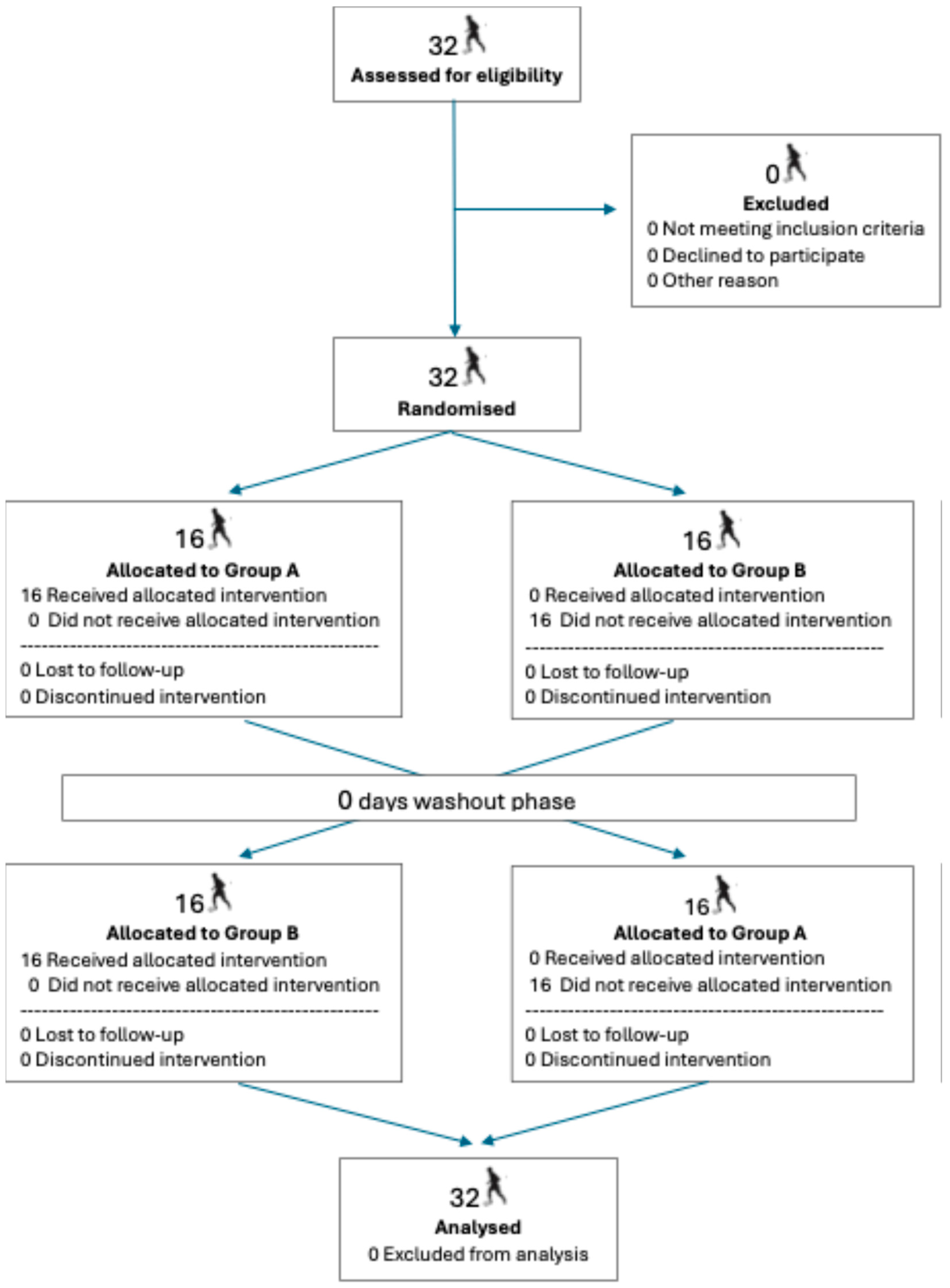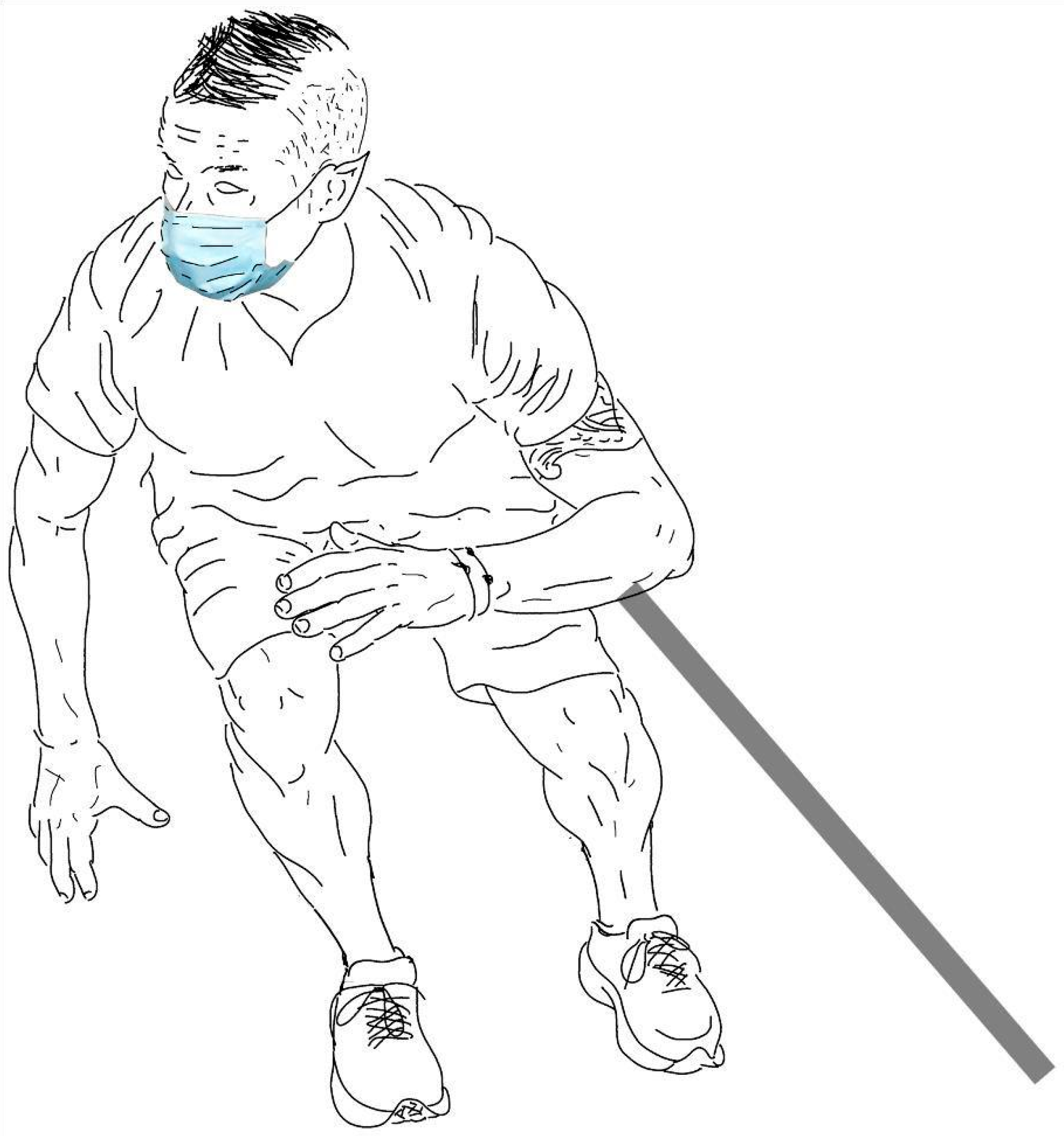Effects of Sidestep Exercise with Elastic Bands on Multidirectional Speed Abilities and Navicular Drop in Young Male Football Players: A Randomized Cross-Over Trial
Abstract
1. Introduction
2. Materials & Methods
2.1. Participants
2.2. Experimental Approach to the Problem
2.3. Procedures
2.3.1. Training Intervention
2.3.2. Navicular Drop Test
2.3.3. The 10 m Speed Test
2.3.4. Curve Sprint Test
2.4. Statistical Analysis
3. Results
4. Discussion
5. Conclusions
6. Practical Applications
Author Contributions
Funding
Institutional Review Board Statement
Informed Consent Statement
Data Availability Statement
Conflicts of Interest
References
- Gonzalo-Skok, O.; Tous-Fajardo, J.; Valero-Campo, C.; Berzosa, C.; Bataller, A.V.; Arjol-Serrano, J.L.; Moras, G.; Mendez-Villanueva, A. Eccentric-Overload Training in Team-Sport Functional Performance: Constant Bilateral Vertical Versus Variable Unilateral Multidirectional Movements. Int. J. Sports Physiol. Perform. 2017, 12, 951–958. [Google Scholar] [CrossRef] [PubMed]
- Filter, A.; Olivares-Jabalera, J.; Dos’Santos, T.; Madruga, M.; Lozano, J.; Molina, A.; Santalla, A.; Requena, B.; Loturco, I. High-intensity Actions in Elite Soccer: Current Status and Future Perspectives. Int. J. Sports Med. 2023, 44, 535–544. [Google Scholar] [CrossRef]
- Morral-Yepes, M.; Moras, G.; Bishop, C.; Gonzalo-Skok, O. Assessing the Reliability and Validity of Agility Testing in Team Sports: A Systematic Review. J. Strength. Cond. Res. 2022, 36, 2035–2049. [Google Scholar]
- Fiorilli, G.; Mariano, I.; Iuliano, E.; Giombini, A.; Ciccarelli, A.; Buonsenso, A.; Calcagno, G.; di Cagno, A. Isoinertial Eccentric-Overload Training in Young Soccer Players: Effects on Strength, Sprint, Change of Direction, Agility and Soccer Shooting Precision. J. Sports Sci. Med. 2020, 19, 213–223. [Google Scholar] [PubMed]
- Lopes, J.S.S.; Machado, A.F.; Micheletti, J.K.; de Almeida, A.C.; Cavina, A.P.; Pastre, C.M. Effects of training with elastic resistance versus conventional resistance on muscular strength: A systematic review and meta-analysis. SAGE Open Med. 2019, 7, 2106903116. [Google Scholar] [CrossRef] [PubMed]
- Brughelli, M.; Cronin, J.; Levin, G.; Chaouachi, A. Understanding Change of Direction Ability in Sport. Sports Med. 2008, 38, 1045–1063. [Google Scholar] [CrossRef]
- Faude, O.; Koch, T.; Meyer, T. Straight sprinting is the most frequent action in goal situations in professional football. J. Sports Sci. 2012, 30, 625–631. [Google Scholar] [CrossRef]
- Oliva-Lozano, J.M.; Fortes, V.; López-Del Campo, R.; Resta, R.; Muyor, J.M. When and how do professional soccer players experience maximal intensity sprints in LaLiga? Sci. Med. Footb. 2023, 7, 288–296. [Google Scholar]
- Chmura, P.; Oliva-Lozano, J.M.; Muyor, J.M.; Andrzejewski, M.; Chmura, J.; Czarniecki, S.; Kowalczuk, E.; Rokita, A.; Konefał, M. Physical Performance Indicators and Team Success in the German Soccer League. J. Hum. Kinet. 2022, 83, 257–265. [Google Scholar] [CrossRef]
- Menz, H. Alternative techniques for the clinical assessment of foot pronation. J. Am. Podiatr. Med. Assoc. 1998, 88, 119–129. [Google Scholar] [CrossRef]
- Picciano, A.M.; Rowlands, M.S.; Worrell, T. Reliability of Open and Closed Kinetic Chain Subtalar Joint Neutral Positions and Navicular Drop Test. J. Orthop. Sports Phys. Ther. 1993, 18, 553–558. [Google Scholar] [CrossRef]
- Adhikari, U.; Arulsingh, W.; Pai, G.; Raj, J.O. Normative values of Navicular drop test and the effect of demographic parameters—A cross sectional study. Ann. Biol. Res. 2014, 5, 40–48. [Google Scholar]
- Fiolkowski, P.; Brunt, D.; Bishop, M.; Woo, R.; Horodyski, M. Intrinsic pedal musculature support of the medial longitudinal arch: An electromyography study. J. Foot Ankle Surg. 2003, 42, 327–333. [Google Scholar] [CrossRef]
- Headlee, D.L.; Leonard, J.L.; Hart, J.M.; Ingersoll, C.D.; Hertel, J. Fatigue of the plantar intrinsic foot muscles increases navicular drop. J. Electromyogr. Kinesiol. 2008, 18, 420–425. [Google Scholar] [CrossRef] [PubMed]
- Okamura, K.; Egawa, K.; Okii, A.; Oki, S.; Kanai, S. Intrinsic foot muscle strengthening exercises with electromyographic biofeedback achieve increased toe flexor strength in older adults: A pilot randomized controlled trial. Clin. Biomech. 2020, 80, 105187. [Google Scholar] [CrossRef] [PubMed]
- McKeon, P.O.; Hertel, J.; Bramble, D.; Davis, I. The foot core system: A new paradigm for understanding intrinsic foot muscle function. Br. J. Sports Med. 2015, 49, 290. [Google Scholar] [CrossRef] [PubMed]
- Allen, M.K.; Glasoe, W.M. Metrecom measurement of navicular drop in subjects with anterior cruciate ligament injury. J. Athl. Train. 2000, 35, 403–406. [Google Scholar]
- Katushabe, E.T.; Kramer, M. Effects of Combined Power Band Resistance Training on Sprint Speed, Agility, Vertical Jump Height, and Strength in Collegiate Soccer Players. Int. J. Exerc. Sci. 2020, 13, 950–963. [Google Scholar]
- Viñas, S.T.; Villa, B.F.-V.; Buxadé, C.P.-C.; González, J.; Feliu, G.M. Decision making influences movement variability and performance of high-level female football players in an elastic resistance task. Front. Psychol. 2023, 14, 1175248. [Google Scholar] [CrossRef]
- Hopkins, W.G.; Marshall, S.W.; Batterham, A.M.; Hanin, J. Progressive Statistics for Studies in Sports Medicine and Exercise Science. Med. Sci. Sports Exerc. 2009, 41, 3–12. [Google Scholar] [CrossRef] [PubMed]
- Loturco, I.; Pereira, L.A.; Reis, V.P.; Zanetti, V.; Bishop, C.; McGuigan, M.R. Traditional Free-Weight Vs. Variable Resistance Training Applied to Elite Young Soccer Players During a Short Preseason: Effects on Strength, Speed, and Power Performance. J. Strength Cond. Res. 2022, 36, 3432–3439. [Google Scholar] [CrossRef] [PubMed]
- Pardos-Mainer, E.; Casajús, J.A.; Bishop, C.; Gonzalo-Skok, O. Effects of Combined Strength and Power Training on Physical Performance and Interlimb Asymmetries in Adolescent Female Soccer Players. Int. J. Sports Physiol. Perform. 2020, 15, 1147–1155. [Google Scholar] [CrossRef] [PubMed]
- Rodríguez-Osorio, D.; Gonzalo-Skok, O.; Pareja-Blanco, F. Effects of Resisted Sprints With Changes of Direction Through Several Relative Loads on Physical Performance in Soccer Players. Int. J. Sports Physiol. Perform. 2019, 14, 1022–1028. [Google Scholar] [CrossRef] [PubMed]
- Tous-Fajardo, J.; Gonzalo-Skok, O.; Arjol-Serrano, J.L.; Tesch, P. Enhancing Change-of-Direction Speed in Soccer Players by Functional Inertial Eccentric Overload and Vibration Training. Int. J. Sports Physiol. Perform. 2016, 11, 66–73. [Google Scholar] [CrossRef]
- de Hoyo, M.; de la Torre, A.; Pradas, F.; Sañudo, B.; Carrasco, L.; Mateo-Cortes, J.; Domínguez-Cobo, S.; Fernandes, O.; Gonzalo-Skok, O. Effects of Eccentric Overload Bout on Change of Direction and Performance in Soccer Players. Int. J. Sports Med. 2014, 36, 308–314. [Google Scholar] [CrossRef]
- Tanaka, T.; Suga, T.; Imai, Y.; Ueno, H.; Misaki, J.; Miyake, Y.; Otsuka, M.; Nagano, A.; Isaka, T. Characteristics of lower leg and foot muscle thicknesses in sprinters: Does greater foot muscles contribute to sprint performance? Eur. J. Sport Sci. 2019, 19, 442–450. [Google Scholar] [CrossRef]


| Pre- | Mid- | Post- | ||||
|---|---|---|---|---|---|---|
| A | B | A | B | A | B | |
| NDR (cm) | 0.08 (0.02) | 0.09 (0.02) | 0.04 (0.03) * | 0.10 (0.04) | 0.04 (0.04) * | 0.10 (0.05) |
| NDL (cm) | 0.07 (0.02) | 0.07 (0.03) | 0.05 (0.03) * | 0.07 (0.04) | 0.05 (0.03) | 0.06 (0.05) |
| 10 m (s) | 1.86 (0.09) | 1.86 (0.11) | 1.77 (0.09) * | 1.84 (0.11) | 1.77 (0.09) * | 1.81 (0.09) *# |
| CSR (s) | 2.66 (0.19) | 2.54 (0.12) | 2.61 (0.17) * | 2.52 (0.14) | 2.59 (0.17) * | 2.47 (0.11) *#^ |
| CSL (s) | 2.83 (0.18) | 2.58 (0.11) | 2.78 (0.17) * | 2.56 (0.11) | 2.77 (0.19) * | 2.52 (0.09) *#^ |
| V-cut (s) | 7.44 (0.43) | 6.98 (0.44) | 7.29 (0.39) * | 6.94 (0.41) | 7.29 (0.35) * | 6.81 (0.39) *#^ |
Disclaimer/Publisher’s Note: The statements, opinions and data contained in all publications are solely those of the individual author(s) and contributor(s) and not of MDPI and/or the editor(s). MDPI and/or the editor(s) disclaim responsibility for any injury to people or property resulting from any ideas, methods, instructions or products referred to in the content. |
© 2025 by the authors. Licensee MDPI, Basel, Switzerland. This article is an open access article distributed under the terms and conditions of the Creative Commons Attribution (CC BY) license (https://creativecommons.org/licenses/by/4.0/).
Share and Cite
Núñez-González, J.L.; Gonzalo-Skok, O.; García, M.J.; Hernández Abad, F.; Núñez, F.J. Effects of Sidestep Exercise with Elastic Bands on Multidirectional Speed Abilities and Navicular Drop in Young Male Football Players: A Randomized Cross-Over Trial. Appl. Sci. 2025, 15, 2892. https://doi.org/10.3390/app15062892
Núñez-González JL, Gonzalo-Skok O, García MJ, Hernández Abad F, Núñez FJ. Effects of Sidestep Exercise with Elastic Bands on Multidirectional Speed Abilities and Navicular Drop in Young Male Football Players: A Randomized Cross-Over Trial. Applied Sciences. 2025; 15(6):2892. https://doi.org/10.3390/app15062892
Chicago/Turabian StyleNúñez-González, Juan L., Oliver Gonzalo-Skok, Manuel J. García, Fernando Hernández Abad, and Francisco J. Núñez. 2025. "Effects of Sidestep Exercise with Elastic Bands on Multidirectional Speed Abilities and Navicular Drop in Young Male Football Players: A Randomized Cross-Over Trial" Applied Sciences 15, no. 6: 2892. https://doi.org/10.3390/app15062892
APA StyleNúñez-González, J. L., Gonzalo-Skok, O., García, M. J., Hernández Abad, F., & Núñez, F. J. (2025). Effects of Sidestep Exercise with Elastic Bands on Multidirectional Speed Abilities and Navicular Drop in Young Male Football Players: A Randomized Cross-Over Trial. Applied Sciences, 15(6), 2892. https://doi.org/10.3390/app15062892






